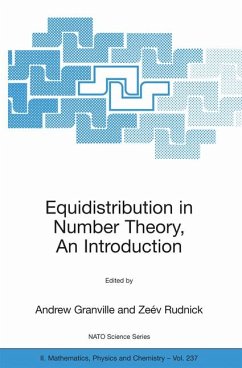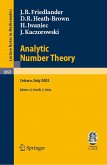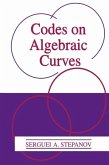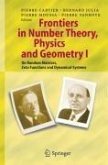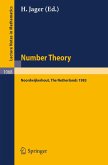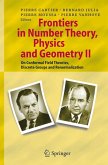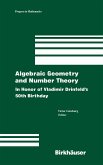Equidistribution in Number Theory, An Introduction (eBook, PDF)
Redaktion: Granville, Andrew; Rudnick, Zeév
274,95 €
274,95 €
inkl. MwSt.
Sofort per Download lieferbar

137 °P sammeln
274,95 €
Als Download kaufen

274,95 €
inkl. MwSt.
Sofort per Download lieferbar

137 °P sammeln
Jetzt verschenken
Alle Infos zum eBook verschenken
274,95 €
inkl. MwSt.
Sofort per Download lieferbar
Alle Infos zum eBook verschenken

137 °P sammeln
Equidistribution in Number Theory, An Introduction (eBook, PDF)
Redaktion: Granville, Andrew; Rudnick, Zeév
- Format: PDF
- Merkliste
- Auf die Merkliste
- Bewerten Bewerten
- Teilen
- Produkt teilen
- Produkterinnerung
- Produkterinnerung

Bitte loggen Sie sich zunächst in Ihr Kundenkonto ein oder registrieren Sie sich bei
bücher.de, um das eBook-Abo tolino select nutzen zu können.
Hier können Sie sich einloggen
Hier können Sie sich einloggen
Sie sind bereits eingeloggt. Klicken Sie auf 2. tolino select Abo, um fortzufahren.

Bitte loggen Sie sich zunächst in Ihr Kundenkonto ein oder registrieren Sie sich bei bücher.de, um das eBook-Abo tolino select nutzen zu können.
This set of lectures provides a structured introduction to the concept of equidistribution in number theory. This concept is of growing importance in many areas, including cryptography, zeros of L-functions, Heegner points, prime number theory, the theory of quadratic forms, and the arithmetic aspects of quantum chaos.
The volume brings together leading researchers from a range of fields who reveal fascinating links between seemingly disparate areas.
- Geräte: PC
- ohne Kopierschutz
- eBook Hilfe
- Größe: 2.71MB
Andere Kunden interessierten sich auch für
![Analytic Number Theory (eBook, PDF) Analytic Number Theory (eBook, PDF)]() J. B. FriedlanderAnalytic Number Theory (eBook, PDF)35,95 €
J. B. FriedlanderAnalytic Number Theory (eBook, PDF)35,95 €![Codes on Algebraic Curves (eBook, PDF) Codes on Algebraic Curves (eBook, PDF)]() Serguei A. StepanovCodes on Algebraic Curves (eBook, PDF)113,95 €
Serguei A. StepanovCodes on Algebraic Curves (eBook, PDF)113,95 €![Frontiers in Number Theory, Physics, and Geometry I (eBook, PDF) Frontiers in Number Theory, Physics, and Geometry I (eBook, PDF)]() Frontiers in Number Theory, Physics, and Geometry I (eBook, PDF)57,95 €
Frontiers in Number Theory, Physics, and Geometry I (eBook, PDF)57,95 €![Elementary Number Theory: Primes, Congruences, and Secrets (eBook, PDF) Elementary Number Theory: Primes, Congruences, and Secrets (eBook, PDF)]() William SteinElementary Number Theory: Primes, Congruences, and Secrets (eBook, PDF)44,95 €
William SteinElementary Number Theory: Primes, Congruences, and Secrets (eBook, PDF)44,95 €![Number Theory, Noordwijkerhout 1983 (eBook, PDF) Number Theory, Noordwijkerhout 1983 (eBook, PDF)]() Number Theory, Noordwijkerhout 1983 (eBook, PDF)30,95 €
Number Theory, Noordwijkerhout 1983 (eBook, PDF)30,95 €![Frontiers in Number Theory, Physics, and Geometry II (eBook, PDF) Frontiers in Number Theory, Physics, and Geometry II (eBook, PDF)]() Frontiers in Number Theory, Physics, and Geometry II (eBook, PDF)69,95 €
Frontiers in Number Theory, Physics, and Geometry II (eBook, PDF)69,95 €![Algebraic Geometry and Number Theory (eBook, PDF) Algebraic Geometry and Number Theory (eBook, PDF)]() Algebraic Geometry and Number Theory (eBook, PDF)113,95 €
Algebraic Geometry and Number Theory (eBook, PDF)113,95 €-
-
-
This set of lectures provides a structured introduction to the concept of equidistribution in number theory. This concept is of growing importance in many areas, including cryptography, zeros of L-functions, Heegner points, prime number theory, the theory of quadratic forms, and the arithmetic aspects of quantum chaos.
The volume brings together leading researchers from a range of fields who reveal fascinating links between seemingly disparate areas.
The volume brings together leading researchers from a range of fields who reveal fascinating links between seemingly disparate areas.
Dieser Download kann aus rechtlichen Gründen nur mit Rechnungsadresse in A, B, BG, CY, CZ, D, DK, EW, E, FIN, F, GR, HR, H, IRL, I, LT, L, LR, M, NL, PL, P, R, S, SLO, SK ausgeliefert werden.
Produktdetails
- Produktdetails
- Verlag: Springer Netherlands
- Seitenzahl: 340
- Erscheinungstermin: 8. April 2007
- Englisch
- ISBN-13: 9781402054044
- Artikelnr.: 37343448
- Verlag: Springer Netherlands
- Seitenzahl: 340
- Erscheinungstermin: 8. April 2007
- Englisch
- ISBN-13: 9781402054044
- Artikelnr.: 37343448
- Herstellerkennzeichnung Die Herstellerinformationen sind derzeit nicht verfügbar.
Preface. Contributors.- Biographical Sketches of the Lecturers. Uniform Distribution.-
1. Uniform Distribution mod One.2. Fractional Parts of an2 .3. Uniform Distribution mod N.4. Normal Numbers. Sieving and the Erdos-Kac Theorem.- Uniform Distribution, Exponential Sums, and Cryptography .- 1 Randomness and Pseudorandomness. 2 Uniform Distribution and Exponential Sums. 3. Exponential Sums and Cryptography. 4. Some Exponential Sum Bounds. 5. General Modulus and Discrepancy of Diffie-Hellman Triples. 6. Pseudorandom Number Generation. 7 Large Periods and the Carmichael Function. 8 Exponential Sums to General Modulus. 9. Sums over Elliptic Curves. 10 Proof Sketch of Theorem 4.1. The Distribution of Prime Numbers.- 1. The Cramer Model and Gaps Between Consecutive Primes. 2 The Distribution of Primes in Longer Intervals. 3 Maier's Method and an "Uncertainty Principle" .- Torsion Points on Curves.- 1. Introduction. 2. A Proof Using Galois Theory. 3. Polynomials Vanishing at Roots of Unity. The distribution of roots of a polynomial.- 1. Introduction. 2 Algebraic Numbers. 3 In k Dimensions: the Bilu Equidistribution Theorem. 4. Lower Bounds on Heights. 5. Compact Sets with Minimal Energy.- Manin-Mumford, André-Oort, the Equidistribution Point of View.- 1 Introduction.2 Informal Examples of Equi-Distribution.3. The Manin-Mumford and the André-Oort Conjecture. 4. Equidistribution of Special Subvarieties; Analytic Methods for the Distribution of Rational Points on Algebraic Varieties.- 1. Introduction to the Hardy-Littlewood Circle Method. 2. Major Arcs and Local Factors in the Hardy-Littlewood Circle Method. 3. The Minor Arcs in the Hardy-Littlewood Circle Method.4. Combining Analytic and Geometric Methods. Universal Torsors over Del Pezzo Surfaces and Rational Points.- 1. Introduction. 2. Geometric Background. 3. Manin's Conjecture. 4. The Universal Torsor. 5. Summations.6. Completion of the Proof. 7. Equations of Universal Torsors.-An Introduction to the Linnik Problems.- 1. Introduction.2. The Linnik Problems. 3. Holomorphic Modular Forms of Half-Integral Weight. 4. Theta Series With Harmonic Polynomials. 5. Linnik Problem for Squares and the Shimura Lift. 6. Nontrivial Estimates for Fourier Coefficients.7. Salié Sums. 8. An Estimate of Iwaniec. 9. Theorems of Gauss and Siegel . 10. The Nonholomorphic Case (Duke, 1988). 11. Transition to Subconvexity Bounds for L-Functions. 12. An Application to Traces of Singular Moduli. Distribution Modulo One and Ratner's Theorem.- 1. Introduction. 2. Randomness of Point Sequences mod 1. 3. ma mod One 4. vma mod One.5. Ratner's Theorem. Spectral Theory of Automorphic Forms: A Very Brief Introduction.- 1. What Is a Homogeneous Space?. 2. Spectral Theory: Compact Case. 3. Dynamics. 4. Spectral Theory: Noncompact Case. 5. Hecke Operators. 6. Gross Omissions: The Selberg Trace Formula. Some Examples How to Use Measure Classification in Number Theory.- 1. Introduction. 2. Dynamical Systems: Some Background. 3. Equidistribution of n2a mod 1. 4. Unipotent Flows and Ratner's Theorems. 5. Entropy of Dynamical Systems: Some More Background. 6. Diagonalizable Actions and the Set of Exceptions to Littlewood's Conjecture. 7. Applications to Quantum Unique Ergodicity.-An Introduction to Quantum Equidistribution.- 1. Introduction. 2. A Crash Course in Classical Mechanics. 3.A Crash Course in Quantum Mechanics. 4. Two Words on Semi-Classical Analysis. 5. Quantum Mechanics on the Torus. The Arithmetic Theory of Quantum Maps.- 1. Quantum Mechanics on the Torus. 2. Quantizing Cat Maps. 3. Quantum Ergodicity. 4. Quantum Unique Ergodicity. 5. Arithmetic QUE
1. Uniform Distribution mod One.2. Fractional Parts of an2 .3. Uniform Distribution mod N.4. Normal Numbers. Sieving and the Erdos-Kac Theorem.- Uniform Distribution, Exponential Sums, and Cryptography .- 1 Randomness and Pseudorandomness. 2 Uniform Distribution and Exponential Sums. 3. Exponential Sums and Cryptography. 4. Some Exponential Sum Bounds. 5. General Modulus and Discrepancy of Diffie-Hellman Triples. 6. Pseudorandom Number Generation. 7 Large Periods and the Carmichael Function. 8 Exponential Sums to General Modulus. 9. Sums over Elliptic Curves. 10 Proof Sketch of Theorem 4.1. The Distribution of Prime Numbers.- 1. The Cramer Model and Gaps Between Consecutive Primes. 2 The Distribution of Primes in Longer Intervals. 3 Maier's Method and an "Uncertainty Principle" .- Torsion Points on Curves.- 1. Introduction. 2. A Proof Using Galois Theory. 3. Polynomials Vanishing at Roots of Unity. The distribution of roots of a polynomial.- 1. Introduction. 2 Algebraic Numbers. 3 In k Dimensions: the Bilu Equidistribution Theorem. 4. Lower Bounds on Heights. 5. Compact Sets with Minimal Energy.- Manin-Mumford, André-Oort, the Equidistribution Point of View.- 1 Introduction.2 Informal Examples of Equi-Distribution.3. The Manin-Mumford and the André-Oort Conjecture. 4. Equidistribution of Special Subvarieties; Analytic Methods for the Distribution of Rational Points on Algebraic Varieties.- 1. Introduction to the Hardy-Littlewood Circle Method. 2. Major Arcs and Local Factors in the Hardy-Littlewood Circle Method. 3. The Minor Arcs in the Hardy-Littlewood Circle Method.4. Combining Analytic and Geometric Methods. Universal Torsors over Del Pezzo Surfaces and Rational Points.- 1. Introduction. 2. Geometric Background. 3. Manin's Conjecture. 4. The Universal Torsor. 5. Summations.6. Completion of the Proof. 7. Equations of Universal Torsors.-An Introduction to the Linnik Problems.- 1. Introduction.2. The Linnik Problems. 3. Holomorphic Modular Forms of Half-Integral Weight. 4. Theta Series With Harmonic Polynomials. 5. Linnik Problem for Squares and the Shimura Lift. 6. Nontrivial Estimates for Fourier Coefficients.7. Salié Sums. 8. An Estimate of Iwaniec. 9. Theorems of Gauss and Siegel . 10. The Nonholomorphic Case (Duke, 1988). 11. Transition to Subconvexity Bounds for L-Functions. 12. An Application to Traces of Singular Moduli. Distribution Modulo One and Ratner's Theorem.- 1. Introduction. 2. Randomness of Point Sequences mod 1. 3. ma mod One 4. vma mod One.5. Ratner's Theorem. Spectral Theory of Automorphic Forms: A Very Brief Introduction.- 1. What Is a Homogeneous Space?. 2. Spectral Theory: Compact Case. 3. Dynamics. 4. Spectral Theory: Noncompact Case. 5. Hecke Operators. 6. Gross Omissions: The Selberg Trace Formula. Some Examples How to Use Measure Classification in Number Theory.- 1. Introduction. 2. Dynamical Systems: Some Background. 3. Equidistribution of n2a mod 1. 4. Unipotent Flows and Ratner's Theorems. 5. Entropy of Dynamical Systems: Some More Background. 6. Diagonalizable Actions and the Set of Exceptions to Littlewood's Conjecture. 7. Applications to Quantum Unique Ergodicity.-An Introduction to Quantum Equidistribution.- 1. Introduction. 2. A Crash Course in Classical Mechanics. 3.A Crash Course in Quantum Mechanics. 4. Two Words on Semi-Classical Analysis. 5. Quantum Mechanics on the Torus. The Arithmetic Theory of Quantum Maps.- 1. Quantum Mechanics on the Torus. 2. Quantizing Cat Maps. 3. Quantum Ergodicity. 4. Quantum Unique Ergodicity. 5. Arithmetic QUE
Preface. Contributors.- Biographical Sketches of the Lecturers. Uniform Distribution.-
1. Uniform Distribution mod One.2. Fractional Parts of an2 .3. Uniform Distribution mod N.4. Normal Numbers. Sieving and the Erdos-Kac Theorem.- Uniform Distribution, Exponential Sums, and Cryptography .- 1 Randomness and Pseudorandomness. 2 Uniform Distribution and Exponential Sums. 3. Exponential Sums and Cryptography. 4. Some Exponential Sum Bounds. 5. General Modulus and Discrepancy of Diffie-Hellman Triples. 6. Pseudorandom Number Generation. 7 Large Periods and the Carmichael Function. 8 Exponential Sums to General Modulus. 9. Sums over Elliptic Curves. 10 Proof Sketch of Theorem 4.1. The Distribution of Prime Numbers.- 1. The Cramer Model and Gaps Between Consecutive Primes. 2 The Distribution of Primes in Longer Intervals. 3 Maier's Method and an "Uncertainty Principle" .- Torsion Points on Curves.- 1. Introduction. 2. A Proof Using Galois Theory. 3. Polynomials Vanishing at Roots of Unity. The distribution of roots of a polynomial.- 1. Introduction. 2 Algebraic Numbers. 3 In k Dimensions: the Bilu Equidistribution Theorem. 4. Lower Bounds on Heights. 5. Compact Sets with Minimal Energy.- Manin-Mumford, André-Oort, the Equidistribution Point of View.- 1 Introduction.2 Informal Examples of Equi-Distribution.3. The Manin-Mumford and the André-Oort Conjecture. 4. Equidistribution of Special Subvarieties; Analytic Methods for the Distribution of Rational Points on Algebraic Varieties.- 1. Introduction to the Hardy-Littlewood Circle Method. 2. Major Arcs and Local Factors in the Hardy-Littlewood Circle Method. 3. The Minor Arcs in the Hardy-Littlewood Circle Method.4. Combining Analytic and Geometric Methods. Universal Torsors over Del Pezzo Surfaces and Rational Points.- 1. Introduction. 2. Geometric Background. 3. Manin's Conjecture. 4. The Universal Torsor. 5. Summations.6. Completion of the Proof. 7. Equations of Universal Torsors.-An Introduction to the Linnik Problems.- 1. Introduction.2. The Linnik Problems. 3. Holomorphic Modular Forms of Half-Integral Weight. 4. Theta Series With Harmonic Polynomials. 5. Linnik Problem for Squares and the Shimura Lift. 6. Nontrivial Estimates for Fourier Coefficients.7. Salié Sums. 8. An Estimate of Iwaniec. 9. Theorems of Gauss and Siegel . 10. The Nonholomorphic Case (Duke, 1988). 11. Transition to Subconvexity Bounds for L-Functions. 12. An Application to Traces of Singular Moduli. Distribution Modulo One and Ratner's Theorem.- 1. Introduction. 2. Randomness of Point Sequences mod 1. 3. ma mod One 4. vma mod One.5. Ratner's Theorem. Spectral Theory of Automorphic Forms: A Very Brief Introduction.- 1. What Is a Homogeneous Space?. 2. Spectral Theory: Compact Case. 3. Dynamics. 4. Spectral Theory: Noncompact Case. 5. Hecke Operators. 6. Gross Omissions: The Selberg Trace Formula. Some Examples How to Use Measure Classification in Number Theory.- 1. Introduction. 2. Dynamical Systems: Some Background. 3. Equidistribution of n2a mod 1. 4. Unipotent Flows and Ratner's Theorems. 5. Entropy of Dynamical Systems: Some More Background. 6. Diagonalizable Actions and the Set of Exceptions to Littlewood's Conjecture. 7. Applications to Quantum Unique Ergodicity.-An Introduction to Quantum Equidistribution.- 1. Introduction. 2. A Crash Course in Classical Mechanics. 3.A Crash Course in Quantum Mechanics. 4. Two Words on Semi-Classical Analysis. 5. Quantum Mechanics on the Torus. The Arithmetic Theory of Quantum Maps.- 1. Quantum Mechanics on the Torus. 2. Quantizing Cat Maps. 3. Quantum Ergodicity. 4. Quantum Unique Ergodicity. 5. Arithmetic QUE
1. Uniform Distribution mod One.2. Fractional Parts of an2 .3. Uniform Distribution mod N.4. Normal Numbers. Sieving and the Erdos-Kac Theorem.- Uniform Distribution, Exponential Sums, and Cryptography .- 1 Randomness and Pseudorandomness. 2 Uniform Distribution and Exponential Sums. 3. Exponential Sums and Cryptography. 4. Some Exponential Sum Bounds. 5. General Modulus and Discrepancy of Diffie-Hellman Triples. 6. Pseudorandom Number Generation. 7 Large Periods and the Carmichael Function. 8 Exponential Sums to General Modulus. 9. Sums over Elliptic Curves. 10 Proof Sketch of Theorem 4.1. The Distribution of Prime Numbers.- 1. The Cramer Model and Gaps Between Consecutive Primes. 2 The Distribution of Primes in Longer Intervals. 3 Maier's Method and an "Uncertainty Principle" .- Torsion Points on Curves.- 1. Introduction. 2. A Proof Using Galois Theory. 3. Polynomials Vanishing at Roots of Unity. The distribution of roots of a polynomial.- 1. Introduction. 2 Algebraic Numbers. 3 In k Dimensions: the Bilu Equidistribution Theorem. 4. Lower Bounds on Heights. 5. Compact Sets with Minimal Energy.- Manin-Mumford, André-Oort, the Equidistribution Point of View.- 1 Introduction.2 Informal Examples of Equi-Distribution.3. The Manin-Mumford and the André-Oort Conjecture. 4. Equidistribution of Special Subvarieties; Analytic Methods for the Distribution of Rational Points on Algebraic Varieties.- 1. Introduction to the Hardy-Littlewood Circle Method. 2. Major Arcs and Local Factors in the Hardy-Littlewood Circle Method. 3. The Minor Arcs in the Hardy-Littlewood Circle Method.4. Combining Analytic and Geometric Methods. Universal Torsors over Del Pezzo Surfaces and Rational Points.- 1. Introduction. 2. Geometric Background. 3. Manin's Conjecture. 4. The Universal Torsor. 5. Summations.6. Completion of the Proof. 7. Equations of Universal Torsors.-An Introduction to the Linnik Problems.- 1. Introduction.2. The Linnik Problems. 3. Holomorphic Modular Forms of Half-Integral Weight. 4. Theta Series With Harmonic Polynomials. 5. Linnik Problem for Squares and the Shimura Lift. 6. Nontrivial Estimates for Fourier Coefficients.7. Salié Sums. 8. An Estimate of Iwaniec. 9. Theorems of Gauss and Siegel . 10. The Nonholomorphic Case (Duke, 1988). 11. Transition to Subconvexity Bounds for L-Functions. 12. An Application to Traces of Singular Moduli. Distribution Modulo One and Ratner's Theorem.- 1. Introduction. 2. Randomness of Point Sequences mod 1. 3. ma mod One 4. vma mod One.5. Ratner's Theorem. Spectral Theory of Automorphic Forms: A Very Brief Introduction.- 1. What Is a Homogeneous Space?. 2. Spectral Theory: Compact Case. 3. Dynamics. 4. Spectral Theory: Noncompact Case. 5. Hecke Operators. 6. Gross Omissions: The Selberg Trace Formula. Some Examples How to Use Measure Classification in Number Theory.- 1. Introduction. 2. Dynamical Systems: Some Background. 3. Equidistribution of n2a mod 1. 4. Unipotent Flows and Ratner's Theorems. 5. Entropy of Dynamical Systems: Some More Background. 6. Diagonalizable Actions and the Set of Exceptions to Littlewood's Conjecture. 7. Applications to Quantum Unique Ergodicity.-An Introduction to Quantum Equidistribution.- 1. Introduction. 2. A Crash Course in Classical Mechanics. 3.A Crash Course in Quantum Mechanics. 4. Two Words on Semi-Classical Analysis. 5. Quantum Mechanics on the Torus. The Arithmetic Theory of Quantum Maps.- 1. Quantum Mechanics on the Torus. 2. Quantizing Cat Maps. 3. Quantum Ergodicity. 4. Quantum Unique Ergodicity. 5. Arithmetic QUE
